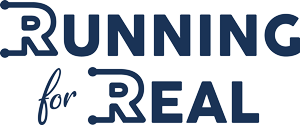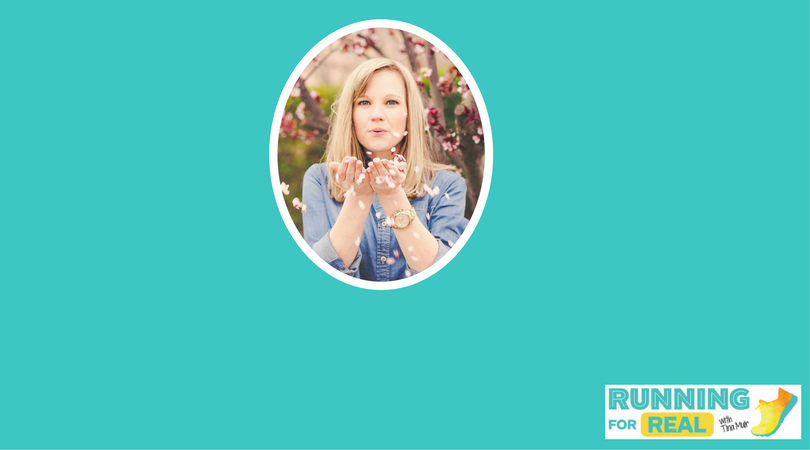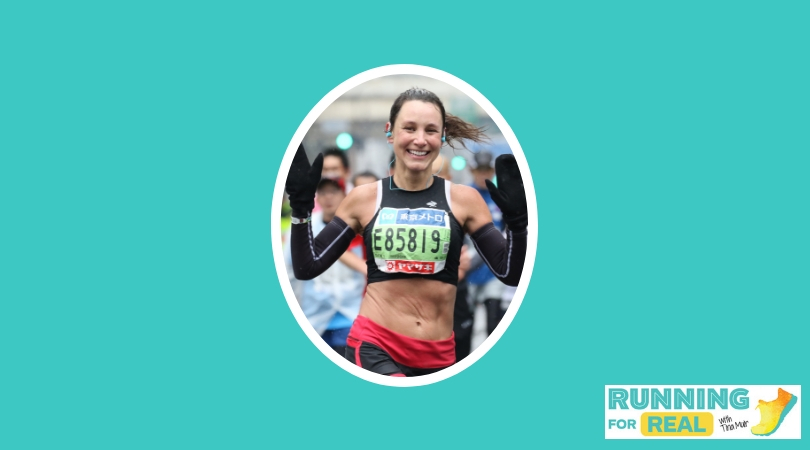Sports science has traditionally focused on men and ignored women. In her new book, Up to Speed: The Groundbreaking Science of Women Athletes, Christine Yu explores the research being done to correct that imbalance and the scientific discoveries that can help women flourish in sports.
Listen to the Running for Real podcast here:
Apple (iTunes) Podcast | Sticher | Castbox | Overcast | Spotify | Google Play | iHeartradio |
Although she’s been athletic all her life, Christine has always felt that her body “didn’t fit with sports.” She would get injured doing “normal” things: tearing her ACL while doing speed work on the track, dislocating her shoulder while swimming. She exercised regularly, strength trained, and felt as though she did everything that she was “supposed to do,” and yet she still got injured.
While researching an article for Outside about the underrepresentation of women in sports science, she realized why she had “this overriding feeling of not fitting quite right.” While it might not explain her entire experience, she says, “It kind of explained to me why I felt like I couldn’t fit because the system around all of this is built in such a way that it does prioritize men. Sports has always been a male-dominated domain. It was built by and for men. And similarly, with the science aspect of it, it’s always been centered around male bodies, male cells, male animals, all of that, to understand biological and physiological functions. So it was kind of the confluence of these different things that helped me start to put words to this feeling that I had about why does it sometimes feel like I chafe against a lot of what’s happening in sports or fitness or exercise? And how I fit into that, what my identity is around that.
“What comes to mind is, my mom would always tell me, ‘Why are you always running so much?’ or ‘Why are you always lifting so much?’ or when I’d get hurt, ‘Maybe you shouldn’t do that much.’ And it’s that narrative, right? That there’s something incompatible either with my specific body and physical activity in sport or women’s bodies in general and physical activity and sport. And so my gut reaction response to her would always be to push back, like, ‘No, I know that there are all these benefits.”
In the broader context though, there hadn’t been much push back to change that narrative. “It’s always been about trying to figure out how to fit within that system, given the constraints of how you fit as a woman within that. How do you not rock the boat? How do you not draw attention? Because truth be told, we’ve fought so hard to be able to play sports in the first place, right? To be able to have access, to be able to have these opportunities. And so for so long it’s been like, well, we should just be grateful that we’ve had these opportunities. And in being grateful and trying to fit ourselves into this mold, it’s often been about ignoring our experience as women and trying to downplay that experience.”
The more she thought about it, the more Christine came to realize that women’s experiences were only a part of the picture. “It’s not just about women,” she says. “When we look at the picture of women in sports, what we often talk about is, you know, this idea that you can’t run because your uterus is gonna fall out or your ovaries are gonna burst. You can’t ski jump because of those same reasons. Or whatever it is, it’s really this guise for policing bodies, in terms of who isn’t appropriate for sport. And so for me, the reason why it’s important to learn more about women in general, and to understand this physiology and the ways in which women have been marginalized, is because we can then learn from that so that we can apply those lessons also to other people who have been marginalized by sex and gender and understand how we can make the whole system more inclusive overall.”
It’s only recently that more attention has been paid to female physiology. A study in conjunction with the London Marathon found that each bra cup size added 4-8 minutes to a runner’s finishing time. “It’s kind of bananas to me that we don’t pay more attention to things like breasts,” Christine observes. “Whether you are an elite athlete or someone who’s performance driven at the recreational level or someone who just cares about their exercise routine, you do so many different things to try to optimize your gains, right? Or to improve adaptability, reduce injury and all of this stuff. And yet with this very prominent, kind of major feature of our bodies, we just brush it aside .
I think it’s largely because breasts are so sexualized, right? They are associated with sex, and so we don’t talk about it. I feel that way with the menstrual cycle too because it’s so tied to fertility that it becomes this topic that we don’t talk about because it has to do with sex. People didn’t really start studying the biomechanics of breast movement until the late two thousands. And so when you don’t understand how breasts move, you can’t create a garment that can help minimize that movement and minimize discomfort and pain. You’re left to just kind of figure it out. It’s just one of the ways in which I feel like women often are put in this position to just figure it out themselves because we don’t have any other options.”
She’s glad to see that attention finally is being paid to the relationship between women’s bodies and their pursuit of sport. “We’ve come to realize that, like I said, the menstrual cycle has to do with more than just our reproductive system. It orchestrates this incredible dance of hormones in our bodies every month. There’s fluctuations up and down across the entire month; we’re not just talking about the few days in which a person might be bleeding, which I think is what a lot of people just think about. And it is one of the most important biological rhythms in the body, probably second to the circadian rhythm.
“Estrogen is probably the most well known ovarian sex hormone that’s associated with the menstrual cycle. But estrogen is critical for things like bone growth and health, and for muscle growth, and for brain function, and for how we metabolize food and all these different things in the body. And all of those factors have an influence and effect on how the body feels in responses to exercise and training in sport. So that’s why it’s important to pay attention to it. And a lot of health care providers now consider the menstrual cycle as a vital sign even, like your blood pressure, or like your heart rate because it can give you a glimpse of what’s going on in your body. When things are out of whack or out of balance, whether it’s nutrition-wise or stress-wise or anything else, the menstrual cycle is one of those first things to start to go a little haywire, if you will.”
Christine does caution, however, that there’s the potential for the science to be taken too far. With greater awareness of how the menstrual cycle affects women’s athletic potential, many women are cycle syncing their workouts. Cycle syncing, she explains, is the idea that “you can sync up certain activities or training based on what phase of the menstrual cycle that you’re in. The idea is that because the hormones are either up or down, there’s ways that you can almost harness or capitalize on these hormonal fluctuations so that you might eke a little bit more out of your workouts.”
The problem with that approach, Christine says, is that everyone’s experience is so individualized. “It becomes another thing that potentially is, quote unquote, wrong with your body. Because I’m supposed to feel, say, more sluggish and tired in the second half of my cycle. But what if I don’t? Does that mean that there’s something wrong? Or if I’m supposed to feel strong and energetic right before ovulation or whatever it is, but that’s the part of my cycle where I just want to be in bed all day, it makes you feel, again, like there’s something wrong with your body.”
She emphasizes that what your own body tells you is what’s important, “not what some trainer on TikTok or some research paper tells you. In the research they’re reporting on average and group response. That’s not anyone’s individual response, per se.”
Christine explores many other topics in Up to Speed, including the need for “a major culture shift” in youth sports, to take the focus away from sport as a means to an end, rather than an activity to be enjoyed for its own sake. Her hope for the book is that “It starts conversations around what it is that we need to change as a society and as a culture to better support women and girls in all ages and phases of their active and athletic life. This isn’t just about elite athletes or sub-elite athletes, this is about everyone. Physical activity and movement and sport play such a big role in a lot of our lives. How can we sustain that and continue to help people be happy while they’re doing these things? Be healthy, and support their full well being while doing these things.”
resources:
Thank you to GotSneakers?, Athletic Greens, and Allbirds for sponsoring this episode.

GotSneakers? makes it socially and financially rewarding to contribute to a circular economy with their FREE sneaker recycling program.
As runners, we go through a lot of shoes, but many of them that we consider “done” still have life for others. In the U.S. alone, at least 200 million pairs of shoes and sneakers wind up in landfills each year, where they can take 30-40 years to decompose. Meanwhile, more than 600 million people worldwide don’t even own a pair of shoes. When you join the GotSneakers? community, you’ll be making a global impact AND you’ll earn money for the shoes that you send them.
Go here to get started!

Athletic Greens has created a movement around simplifying our health routine. AG1 is an easy way to get 75 vitamins, minerals, and whole food source ingredients. It promotes gut health with prebiotics, probiotics, and naturally occurring enzymes; supports your immune system with Vitamin C, zinc, healing mushrooms, and more; provides magnesium to boost energy; and it’s packed with superfoods, adaptogens, and antioxidants to help recovery. It’s simple to make and it tastes good!
Just one scoop in a glass of water in the morning will ensure that even if your diet is less than ideal the rest of the day, you’ve gotten the nutrients you need. Go here to subscribe and you’ll get five free travel packs of AG1, and a free one year’s supply of vitamin D3+K2 with your subscription!

Allbirds looks at everything through a sustainability lens; it’s at the core of who they are as a company and the products they create. Their performance running shoe, the Tree Flyer, is lightweight, super springy, and wildly comfortable, and they’re Tina’s go-to running shoes. The Tree Dasher is not only a running shoe, it’s perfect for daily wear. You might also want to check out the Plant Pacers, made from plant leather.
Use this link, and you’ll get a free pair of socks! Just add them to your order, and when you use this link, it will take off the price at the end.
Thanks for listening!
If you haven’t already, be sure to subscribe on Apple, Spotify, iHeart, Stitcher, YouTube, or wherever you get your podcasts. And if you enjoy Running for Real, please leave us a review!
Keep up with what’s going on at Running for Real by signing up for our weekly newsletter.
Join the newsletter
This is not your usual email newsletter. With Tina’s personal reflections and recommendations, suggestions of things to do, thoughts to contemplate, and some updates, this newsletter is one that you’ll WANT to read, not hit “delete” as soon as you see it.
Follow Tina on Instagram, Facebook, and Twitter. You’ll find Running for Real on Instagram too!
Want to be a member of the Running for Real community? Join #Running4Real Superstars on Facebook!
Subscribe to our YouTube channel for additional content, including our RED-S: Realize. Reflect. Recover series of 50+ videos.
Thank you for your support – we appreciate each and every one of you!



